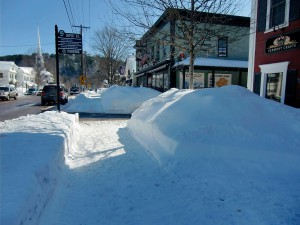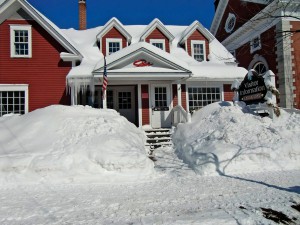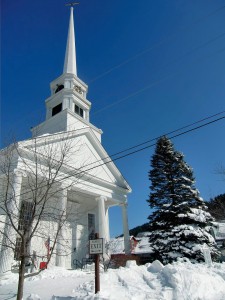IN SEARCH OF SNOW – VERMONT’S DEEP SNOW
IN SEARCH OF SNOW
This is the tenth in a series of articles about traveling by rail in search of snow
VERMONT’S DEEP SNOW
By Charles N. Stevens
Photos by Dolores Seidman
Waking up rested after a sound sleep, we peer out our windows at the smooth mounds of snow drifts and clear icicles hanging from the eaves. The branches of a pine tree are spread with fan-like patches of snow.
The temperature outside is 5 degrees as we make our way to breakfast, the frozen snow and rock salt popping under our shoes. We are told that 23 inches of snow had fallen in 24 hours, a near record for Stowe, and very tough for even them to cope with. As we have breakfast we can see many trucks fitted with plows passing through town.
Dolores and I decide to venture out into the wintery scene, the temperature now having warmed up to 10 degrees. After all, the point of our trip is to see snow, so it’s time to get out in it. We walk slowly and gingerly over the packed snow on the sidewalks, our lack of experience making us a bit wary. Drifts rise on both sides of the walk, but the plowed roads are clear. The morning sun is dazzling and the air is still, allowing us to be quite comfortable in our heavy jackets. As we begin to walk in the icy surroundings with more confidence, we photograph its cold beauty.
Perhaps a block away from our inn stands the pointed white steeple of the Methodist Church. Slowly we make our way to it. Pushing open the unlocked door, we stand in its white, bare interior, its pews low, a single cross over the altar its only symbol.
We decide to ride the free shuttle that takes passengers all around Stowe and the many lodges, homes and conference centers in the hilly area surrounding the village. The roads are clear, but deep snow dominates the landscape. We pass several places renting snowmobiles and even an outfit that offers rides in Christmas card-like sleighs drawn by horses. The men who operate it are busy digging the sleigh out of the snow. The bus takes us far up into the ski areas where the chair lifts are active and skiers race down the hills drawing tracks in the fresh fallen snow. Enclosed gondolas transport skiers up to Spruce Mountain and Mount Mansfield. The bright sun on the snow is hard on our eyes, but the shuttle ride gives us a series of spectacular snow vistas that will forever be in our memories.
Stowe, Vermont, nestled in the Green Mountains, has a population of about 4300 people. Its industries of the past were lumber and maple syrup, but now its chief source of income is tourism. Its stores, shops and restaurants along Main Street make it a quaint shopping town in every season. During summer they have a wine and food festival.
The Trapp Family Lodge reminds today’s tourists that they once lived in Stowe. The Trapp Family Singers, already famous in their native Austria, moved to Vermont in the 1940s. From their home in Stowe they toured cities in the United States. When not traveling, they were busy with a music camp near their home. In 1949 Maria von Trapp wrote her book, The Story of the Trapp Family Singers from which the Germans made two films and the United States one, The Sound of Music.
Wanting only a light lunch, we had pushed our containers of Ensure into a snowdrift to chill them, which worked exceedingly well. From our room, I watch a long icicle slowly grow from the roof outside our door. Another one breaks off, plunging below, stabbing itself upright in a snow bank.
Later, we refresh ourselves with hot cider and cookies in the lounge, a perfect buffer against the chilly weather outside. As the afternoon progresses and the temperature drops, the icicles stop dripping. The pool, available for swimming, steams vigorously in the chill air, but I see no takers.
At dinner time, too cold to venture outside, we dine at The Whip, the restaurant in the Green Mountain Inn. In its warm and friendly atmosphere Dolores selects Cod while I indulge in one of my favorite dishes, steak au poivre.
Satisfied but weary, we make our way back to our cozy room, the arctic air nipping at our noses, our shoes crunching bits of frozen snow and crystals of rock salt.

We begin our morning walk, very gingerly, in the deepest snow we had ever seen
.

Drifts are piled up against the Green Mountain Inn.

Our first goal is a visit to this typical New England church.

A small covered bridge leads out into the snow-covered hills.
MONTEREY PARK AUTHOR PUBLISHES 3RD BOOK ABOUT HIS EXPERIENCES IN WORLD WAR II- BACK FROM COMBAT
Charles “Norm” Stevens, a 40 year resident of Monterey Park and World War II Veteran has recently published the 3rd in his series about his experiences in WW II, Back from Combat: A WWII Bombardier Faces His Military Future. This book details the time from when he returned from combat in England where he flew 34 missions over Germany and France until the end of the war. Faced with large numbers of returning combat vets, and not knowing how long the war would continue, the military had to plan for their future. His options were whether to return to combat, become an instructor in the U.S., or receive new training that he would use in the Pacific. The book concludes with the end of the war with an Afterward that includes an update on the B-l7’s still flying in the U.S., as well as present day accounts pertaining to the war.
Stevens is the author of two previous books about his experiences:
An Innocent at Polebrook: A Memoir of an 8th Air Force Bombardier (Story of his 34 bombing missions from his base at Polebrook, England over Germany and France)
The Innocent Cadet: Becoming A World War II Bombardier (A prequel to the first, telling of his training in the U.S. before going overseas into combat.)
He is known to the readers of The Citizen’s Voice as the author of Travel Log Articles including “From Paris to Normandy on the Seine”, “Exploring New York” and “In Search of Snow.” He is retired, having taught for 32 years, primarily in the Montebello Unified School District.
Those interested in purchasing an autographed copy of any of his books, may contact the author at 323-721-8230 or Normstevens24@gmail.com.



